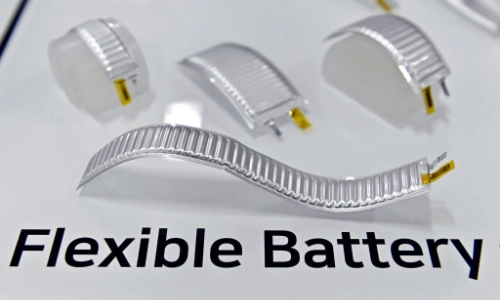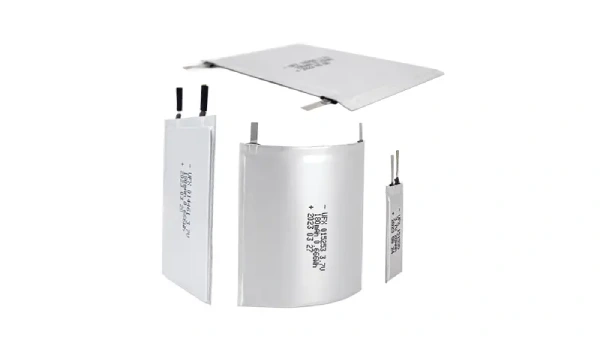Flexible batteries are a new type of battery that can bend and twist. They are different from regular batteries in many ways. Understanding these differences is essential for users to know how modern batteries work and where they can effectively use them. This article will explore how flexible batteries compare to regular batteries.
Part 1. Understanding flexible and regular batteries
Flexible Batteries
Flexible batteries are batteries that can bend, twist, and stretch. Manufacturers make them using unique materials that allow them to be flexible. These materials include thin films of metals, flexible plastics, and special gels. Flexible batteries are very light and can fit into small, curved spaces. People often use them in wearable devices, bright clothing, and foldable phones. They also work well in medical devices that must move with the body.
- Thin Materials: Flexible batteries use thin, lightweight materials.
- Bendable and Stretchable: They can bend and stretch without breaking.
- Versatile Shapes: They fit into many different shapes and sizes.
Regular Batteries
Regular batteries are the standard batteries we use every day. You can find them in remote controls, toys, and flashlights. These batteries have a solid, stiff structure. Manufacturers make them from metal cases, liquid electrolytes, and metal electrodes. Regular batteries are usually cylindrical or rectangular. They have a fixed shape and cannot bend or flex. They are solid and reliable but cannot fit into flexible or small spaces as flexible batteries can.
- Solid Structure: Regular batteries have a complex, solid shape.
- Common Shapes: They are usually cylindrical or rectangular.
- Reliable Power: They provide steady and dependable power for many devices.
Part 2. Structural and material differences
Comparison of Design Aspects:
Flexible Batteries:
- Engineered to bend and adapt to various shapes.
- Utilize thin layers of flexible materials like plastics and lightweight metals.
- Fit into curved or small spaces without compromising performance.
- Ideal for wearable technology and flexible electronics applications.
Regular Batteries:
- Characterized by a rigid and solid design.
- It features a sturdy outer casing made of metal or hard plastic.
- Enclose thick layers of electrodes and liquid or gel electrolytes.
- Ensure stability and durability but lack flexibility for unconventional shapes.
How Flexibility is Achieved:
Flexible Batteries:
- Researchers selected materials that bend and stretch without breaking.
- It is layered to maintain electrical conductivity while allowing physical flexibility.
- Enable integration into devices requiring dynamic forms, such as curved displays or wearable health monitors.
Regular Batteries:
- It depends on a robust internal structure tightly packed within a fixed framework.
- Designed for reliable performance over time but limited in adaptability to bending or twisting.
Materials in Flexible Batteries:
- Flexible Substrates: Thin, pliable plastics that provide a flexible foundation.
- Solid-State Electrolytes: Maintain conductivity without the risk of leakage, which is crucial for flexibility.
- Thin Metal Films for Electrodes: Enhance flexibility while maintaining energy storage capabilities.
Materials in Regular Batteries:
- Rigid Casings: Constructed from hard metals or durable plastics for structural integrity.
- Liquid or Gel Electrolytes: Facilitate ion movement between electrodes, essential for electrical performance.
- Thick Metal Layers for Electrodes: Prioritize longevity and stability over flexibility.
Part 3. Performance and efficiency
Comparison of Energy Density and Storage Capacity:
Flexible Batteries:
- Typically, they have lower energy density compared to regular batteries.
- Due to the use of lighter materials and thinner electrodes.
- Suitable for applications where size and weight are critical factors.
Regular Batteries:
- Known for higher energy density.
- Utilize thicker electrodes and denser materials.
- Many users prefer them for devices that require longer operating times between charges.
Factors Affecting Energy Capacity:
Material Composition:
- Flexible batteries use lightweight materials that reduce overall energy storage capacity.
- Regular batteries employ denser materials to maximize energy storage per volume.
Design Considerations:
- The design of flexible batteries prioritizes flexibility over energy density.
- Regular batteries optimize internal space for higher-capacity components.
Analysis of Charge and Discharge Rates:
Flexible Batteries:
- They tend to have slower charge and discharge rates.
- Due to the thinner electrodes and materials used.
- Suitable for applications with lower power demands.
Regular Batteries:
- Typically feature faster charge and discharge rates.
- Thicker electrodes and efficient electrolyte systems enable it.
- It is ideal for devices requiring quick power replenishment.
Impact on Overall Battery Efficiency:
Efficiency in Flexible Batteries:
- Despite slower rates, users maintain efficiency through stable charge retention.
- Well-suited for devices with intermittent power needs.
Efficiency in Regular Batteries:
- Higher rates contribute to overall efficiency in power-intensive applications.
- Ensures consistent performance and reliability in demanding environments.
Part 4. Applications and use cases
Applications of Flexible Batteries
Wearable Devices:
- Flexible batteries are ideal for smartwatches, fitness trackers, and health monitoring devices.
- Conform to the shape of the body, providing comfort and mobility.
Flexible Electronics:
- Tech companies use them in foldable phones, flexible displays, and roll-up keyboards.
- Enable innovative designs that can adapt to different form factors.
Medical Implants:
- Power implantable medical devices such as pacemakers and insulin pumps.
- Provide reliable energy supply while conforming to body movements.
New Industries:
- They are driving advancements in wearable technology and healthcare sectors.
- They are facilitating the development of next-generation consumer electronics.
Applications of Regular Batteries
Smartphones and Laptops:
- Regular batteries power portable electronic devices for everyday use.
- Provide consistent and high-capacity energy storage.
Electric Vehicles:
- Essential for electric cars, buses, and bikes.
- Support long-distance travel and sustainable transportation solutions.
Comparison of Use Cases:
Adaptability:
- Flexible batteries excel in applications requiring bendable and lightweight power sources.
- Users prefer regular batteries for devices with fixed shapes and higher energy demands.
Part 5. Advantages and limitations
Advantages of Flexible Batteries
- Lightweight: Flexible batteries use lightweight materials, making them easy to carry and integrate into various devices.
- Adaptability: They can bend and conform to different shapes, enabling innovative designs such as curved displays and wearable electronics.
- Integration into Innovative Designs: Suitable for applications requiring flexible form factors, enhancing the functionality of products like bright clothing and foldable gadgets.
- Portable Applications: Enable lighter and more portable technology solutions, benefiting industries like healthcare and aerospace.
- Flexible Form Factors: Promote creativity in product design, fostering new trends in consumer electronics and automotive sectors.
Limitations of Flexible Batteries
- Energy Density: Limited energy storage capacity compared to regular batteries due to thinner electrodes and materials.
- Cost: Higher production costs are associated with specialized materials and manufacturing processes.
- Manufacturing Complexities: Challenges in scaling production while maintaining quality and performance standards.
- Improving Energy Storage: Research and development focused on enhancing energy density without compromising flexibility.
- Reducing Costs: Innovations are needed to lower production costs and make flexible batteries more economically viable.
- Streamlining Manufacturing Processes: Addressing complexities to achieve mass production and meet market demands efficiently.
Advantages of Regular Batteries
- High Energy Density: Regular batteries offer substantial energy storage capacity, supporting long-term usage in demanding applications.
- Reliability: Known for consistent performance and durability, ensuring reliable power supply in critical devices.
- Wide Availability: Mass production capabilities lead to widespread availability and accessibility across global markets.
- Lower Production Costs: Economies of scale contribute to cost-effectiveness, benefiting consumers and industries alike.
Limitations of Regular Batteries
- Lack of Flexibility: Fixed form factors restrict use in devices requiring flexible designs or unconventional shapes.
- Size and Weight Issues: Bulkier and heavier than flexible batteries, limiting applications in lightweight and compact products.
- Environmental Concerns: Disposal and recycling challenges due to materials like heavy metals and liquid electrolytes.
Part 6. FAQs
-
Can flexible batteries be used in extreme temperatures?
Flexible batteries have temperature limitations depending on their materials. Some can operate from -20°C to 60°C, but extreme heat or cold may affect performance. -
Are flexible batteries safe for use in wearable devices?
Yes, manufacturers design flexible batteries with safety in mind. They use non-toxic materials and solid-state electrolytes to prevent leakage, making them suitable for close contact with the skin. -
What are the environmental impacts of flexible versus regular batteries?
Flexible batteries generally use less material and have the potential for easier recycling than regular batteries, which often contain heavy metals and liquid electrolytes. -
Do flexible batteries have a shorter lifespan than regular batteries?
The lifespan of flexible batteries depends on usage patterns and environmental factors. They may have similar or slightly shorter lifespans than regular batteries under normal conditions. -
Can flexible batteries replace regular batteries in all applications?
Flexible batteries excel in applications requiring bendable form factors. Still, regular batteries remain essential for devices needing high energy density and rigid structure, such as electric vehicles and laptops.
Related Tags:
More Articles

LiPo Battery Discharge Rate Guide & Calculation Tips
Understand LiPo battery discharge rates, C-ratings, and how to calculate max current. Essential guide for RC, drones, and electronics users.
High‑Capacity 3S LiPo Batteries: 5000 mAh vs. 10000 mAh
Compare 3S LiPo 5000mAh vs 10000mAh batteries by weight, power, and use. Find the best fit for your drone, RC car, or boat setup.
Top 5 Applications for Small 3S LiPo Batteries
Small 3S LiPo batteries power drones, RC gear, wearables, and robotics with high energy and low weight. Making them ideal for compact electronics projects.
Building and Charging Your Own 3S LiPo Pack: A Step‑by‑Step Guide
Learn how to build, balance, and charge a 3S LiPo battery pack safely at home with this complete DIY guide for hobbyists and beginners.
How to Choose the Right LiPo Battery Plug Type?
Discover the best LiPo battery plug types, how to choose them, and expert tips for safe usage, soldering, and maintenance.





